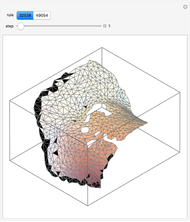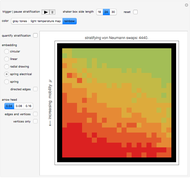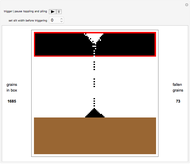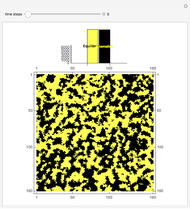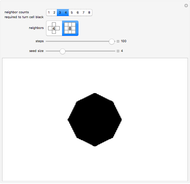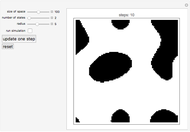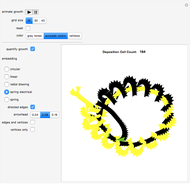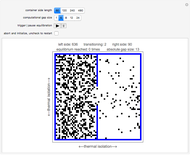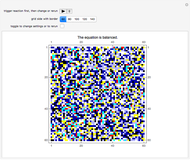{1,1} Surface Deposition with {-1,1} Growth

Requires a Wolfram Notebook System
Interact on desktop, mobile and cloud with the free Wolfram Player or other Wolfram Language products.
Deposition material is deposited from the top toward the bottom. This deposit is allowed to stick only to the top of the substrate or to the top of the deposit. Cells embedded in the substrate's surface represent defects in that substrate and are not allowed to fill. The region above the substrate is assumed to be evacuated. The surface reconfigures itself with every cycle.
[more]
Contributed by: Michael Dewus (May 2011)
Open content licensed under CC BY-NC-SA
Snapshots
Details
Activation energy, bond strength, charging, diffusion, and thermal effects are not considered in the computation—vacant site deposition and post-deposition growth is based on neighborhood configuration rules alone.
Check the "quantify growth" control at any time to switch between the matrix plot simulation of the growth and a network quantification of this simulation. Color information is synchronized between these two views; change the color setting at any time. The quantification is exhaustive on a per cell basis.
With "quantify growth" checked, check the "directed edges" control to follow the information flow throughout the surface (use the "directed edges" control with any of the network embedding methods; linear embedding is informative with both settings of this control). Edge colors are determined by the datum of the vertex a given arrow points to; vertex formats are shown below.
Use the control "edges and vertices" or "vertices only" to get vertex information (please note that "vertices only" has precedence)—pause and mouseover a vertex of interest to locate it on the surface. Vertices have this format: {{cell row, cell column}, cell state}.
References
[1] B. Chopard and M. Droz, Cellular Automata Modeling of Physical Systems, Cambridge: Cambridge University Press, 2005.
[2] R.C. Jaeger, Introduction to Microelectronic Fabrication: Modular Series on Solid State Devices, Vol. V., Reading, MA: Addison–Wesley, 1993.
[3] A.B. Glaser and G.E. Subak–Sharpe, Integrated Circuit Engineering, Reading, MA: Addison-Wesley, 1979.
[4] Wikipedia, "Sputtering." (Jun 14, 2013) en.wikipedia.org/wiki/Sputtering.
[5] Wikipedia, "Negative Feedback." (Jun 14, 2013) en.wikipedia.org/wiki/Negative_feedback.
[6] Wikipedia, "Positive Feedback." (Jun 14, 2013) en.wikipedia.org/wiki/Positive_feedback.
Permanent Citation
"{1,1} Surface Deposition with {-1,1} Growth"
http://demonstrations.wolfram.com/11SurfaceDepositionWith11Growth/
Wolfram Demonstrations Project
Published: May 2 2011






